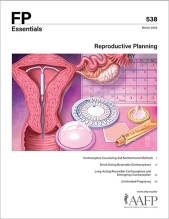
This clinical content conforms to AAFP criteria for CME.
More than 65% of US women ages 15 to 49 years use contraception every year, many of whom seek care with family medicine. Family physicians are well equipped to provide comprehensive contraceptive counseling to patients in the primary care setting. When discussing options and providing education to patients, clinicians should consider patient preferences, patient autonomy, and adverse effect concerns, and should use a patient-centered approach that upholds the principles of reproductive justice. Nonhormonal methods of contraception include barrier methods and spermicides, fertility awareness–based methods, and (in postpartum individuals) lactational amenorrhea. With barrier methods, spermicides, and fertility awareness–based methods, 13 to 29 out of 100 women may become pregnant. Permanent forms of contraception include female and male sterilization procedures, which are some of the most effective (more than 99% effective) and most commonly used methods in the United States.
Case 1. JH is a 26-year-old, gravida 1 para 1, patient who comes to your office with her spouse inquiring about using a diaphragm for contraception. They prefer nonhormonal methods and do not want an intrauterine device. JH also heard about the calendar method from a friend and wonders if she can combine that with a diaphragm for contraception.
Contraceptive Counseling
Approximately 45 million women in the United States each year are sexually active but are not seeking to become pregnant.1 More than 65% of US women ages 15 to 49 years use contraception every year.2 Because the majority of outpatient care sought by reproductive-age females is from family physicians or obstetrician-gynecologists,3 all family physicians should be able to provide comprehensive contraceptive counseling and education. Contraceptive counseling, informed by the principles of reproductive autonomy and justice, can ensure unbiased and equitable provision of options and services to all patients. Studies have shown that clinician bias exists in sexual and reproductive health service provision, and such bias affects the experience of patients by creating undue barriers to accessing contraceptive services or information.4
Subscribe
From $350- Immediate, unlimited access to FP Essentials content
- 60 CME credits/year
- AAFP app access
- Print delivery available
Edition Access
$44- Immediate, unlimited access to this edition's content
- 5 CME credits
- AAFP app access
- Print delivery available
